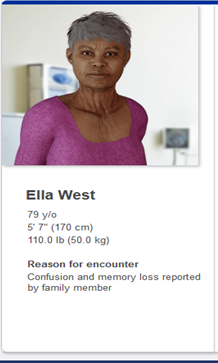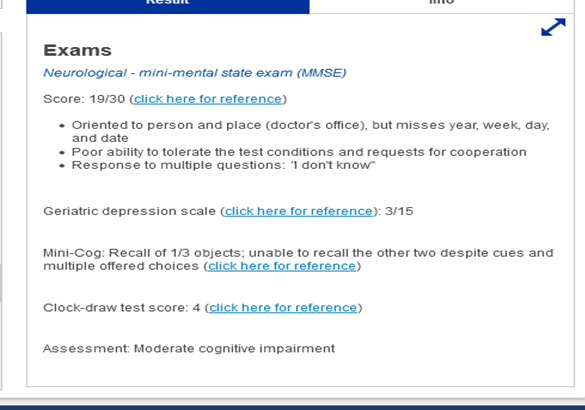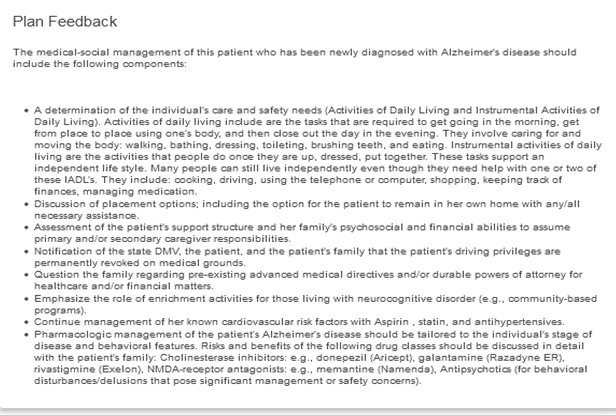NR 601 Week 6 Ella West Ihuman Reflection Example Answer Provided
Reflection: Address the following questions:
- Caring for clients with memory loss can be challenging for caregivers and for providers. What ethical challenges might the provider face and what resources are available to ensure appropriate, ethically sound care for this client and her family?
DX: Alzheimer’s with agitation///middle-stage issues (money management, agitation, sundowning, crying in the evening)
- Include the following components:
- Write 150-300 words in a Microsoft Word document.
- Demonstrate clinical judgment appropriate to the virtual patient scenario.
- Cite at least one relevant scholarly source as defined by program expectations (scholarly of < 5 years.)
- Communicate without errors in English grammar, spelling, syntax, and punctuation.



NR 601 Week 1 Discussion
Follow these guidelines when completing each component of the assignment. Contact your course faculty if you have questions.
Health inequities result in poor health outcomes creating a burden on clients, families, and communities. One of the areas of impact is in life expectancy. Several factors impact life expectancy, including genetics, race, socioeconomic status, and lifestyle choices.
Surprisingly, one of the most significant predictors of life expectancy is zip code. View this brief video https://www.youtube.com/watch?v=Eu7d0BMRt0o on the correlation of zip code to life expectancy. Then, follow the directions below to gather information for your initial discussion post. You may gather information for your home county or for the area in which you intend to practice.
Application of Course Knowledge:
- Describe county-level demographics:
- Visit the United States Census Bureau website https://data.census.gov/advanced
- Use the Geography filter in the left menu. Select your state and county. Click the SEARCH button.
- View the profile for your county. The link may be found under the county map.
- Identify your county and state. Briefly describe demographic data for your county, including total population, median income, percentage of residents with health insurance, poverty percentage, and one additional demographic. Compare the data to state averages and discuss your findings.
- Evaluate life expectancy data:
- Access the NCHS Data Visualization Gallery site https://www.cdc.gov/nchs/data-visualization/life-expectancy/
- Select your state and county from the dropdown menus on the interactive map.
- Find the census tract with the highest life expectancy and the tract with the lowest life expectancy within your county. Compare these rates with the state and national averages.
- Identify and describe demographic factors in the selected county that may play a role in life expectancy.
- Explain the implications of this data for your future practice.
- Cite 3 scholarly sources of <5yrs. in the initial post
NR 601 Week 1 Discussion Example Answer
Describing County Demographics
With 79,462 residents overall, Bedford County, Virginia, has a far smaller population than the state of Virginia, which has 8,631,393 residents. (USCB, 2023) The disparity in population size may have consequences for the county’s resources and healthcare accessibility.
In terms of economic considerations, Bedford County’s median income is $71,751 (± $6,581), which is much less than the state average of $85,873 (± $763) (United States Census Bureau (USCB), 2023). The county’s greater median income might indicate a wealthier populace, which might have an effect on their capacity to get high-quality medical treatment.
The percentage of people in Bedford County with health insurance is 94.3%, higher than the 93.5% average for the state (USCB, 2023). This high coverage percentage could mean that most locals have health insurance to cover medical costs, which would improve their general well-being.
Bedford County’s poverty rate is significantly lower than the state average, which is 10.6% (±0.3%), at 7.1% (±2.1%) (USCB, 2023). Reduced rates of poverty are associated with better living conditions and easier access to healthcare resources for locals (American Academy of Family Physicians, 2021).
Another demographic characteristic is the median age, which is considerably higher in Bedford County at 47.6 years (± 0.6) than it is in the state average of 39.0 years (± 0.2) (USCB, 2023). Given that older populations frequently need more comprehensive healthcare services, this age gap may have an impact on the county’s healthcare demands.
Additionally, Bedford County has 3.9% (±1.5%) of Italian ancestry, which is somewhat higher than the state average of 3.8% (±0.1%) (USCB, 2023). Healthcare practices and outcomes may be impacted by cultural preferences and health behaviors influenced by one’s ancestral heritage (Swihart & Martin, 2023).
These demographic variations between Bedford County and the state of Virginia reveal the distinctive qualities of the county’s population. These variances can have a significant impact on healthcare disparities, service accessibility, and life expectancy in general. Healthcare professionals who want to effectively address the local population’s unique demands must comprehend these distinctions.
Evaluating Life Expectancy Data
Within Bedford County, Virginia, there exists a disparity in life expectancy among various census tracts. The census tract with the highest life expectancy is 0301.03, where the residents have an average lifespan of 83.0 years. This statistic exceeds both the averages at the state and national levels, suggesting superior health outcomes and general well-being in this particular region.
Conversely, census tract 0306.03 exhibits the lowest life expectancy, with residents having a lifespan of 73.0 years, which is notably lower than both the state and national averages (Centers for Disease Control and Prevention [CDC], 2020). This indicates that there are significant differences in health outcomes within this specific area.
By comparing these rates with the averages at the state and national levels, it becomes evident how crucial it is to tackle health disparities within Bedford County. The variations in life expectancy are undoubtedly influenced by multiple complex factors.
The census tract with a greater life expectancy may be characterized by improved accessibility to healthcare facilities, perhaps elevated median income levels, reduced poverty rates, and a more prosperous demographic. In contrast, the area with a shorter average lifespan may encounter obstacles in reaching medical services, experience higher levels of poverty, and may have a lower median income (Massey et al., 2023).
As a healthcare practitioner in Bedford County, it is imperative to acknowledge and tackle the variations in life expectancy among different census tracts within the county. Customizing healthcare interventions to the unique requirements of individual communities and tackling the social factors that influence health, such as income, poverty, and healthcare accessibility, can enhance overall life expectancy and health results.
Gaining insight into the demographic variables that impact life expectancy in various regions is crucial for providing patient-centered care and developing successful health promotion initiatives. Healthcare providers can strive to diminish health disparities and enhance the general well-being of the population in Bedford County, Virginia, by addressing the distinct requirements and constraints each community faces.
References
American Academy of Family Physicians. (2021, April). Poverty and Health – The Family Medicine Perspective (Position Paper). Www.aafp.org. https://www.aafp.org/about/policies/all/poverty-health.html
Centers for Disease Control and Prevention. (2020, February 28). Life expectancy data viz. Www.cdc.gov. https://www.cdc.gov/nchs/data-visualization/life-expectancy/
Massey, J. S., Wiese, D., McCullough, M. L., Jemal, A., & Islami, F. (2023). The Association Between Census Tract Healthy Food Accessibility and Life Expectancy in the United States. Journal of Urban Health, 100(3), 572–576. https://doi.org/10.1007/s11524-023-00742-x
Swihart, D. L., & Martin, R. L. (2023). Cultural Religious Competence In Clinical Practice. National Library of Medicine; StatPearls Publishing. https://www.ncbi.nlm.nih.gov/books/NBK493216/
United States Census Bureau (USCB). (2023). Bedford County, Virginia. Data.census.gov. https://data.census.gov/all?q=Bedford+County


